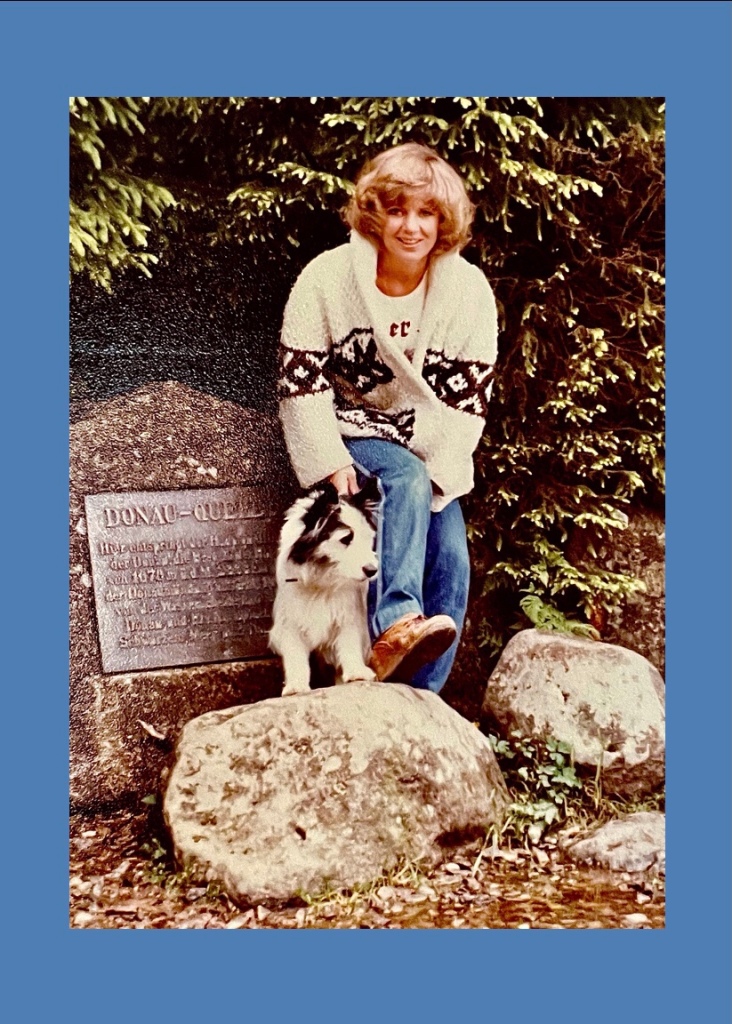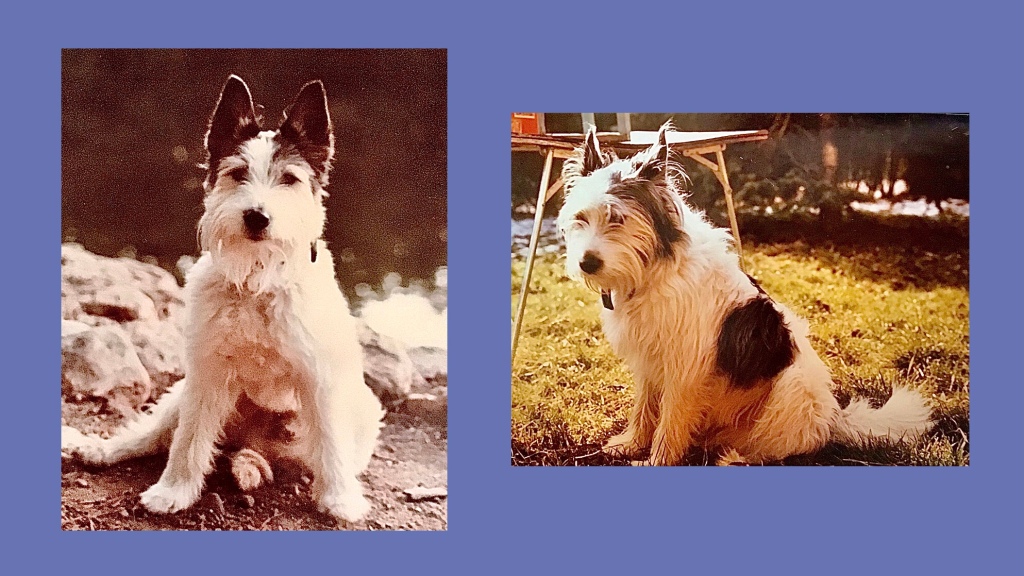With no kids to talk about, Cath and I have a million stories about our dogs, particularly our first dog, Top. Don’t parents always have the most pictures and stories about their first born?! A German friend called Top “Einmalig”, which translates to “one of a kind”. This story, from 1981, involved Top, Cathy hitting a tree with our car, the MPs, the German Polizei and a little old lady. We were stationed in Würzburg, Germany at the time.

Cathy had been shopping at the commissary and was returning home with both Top and our groceries in the back seat. Here is her version of what happened.
#—#
Top and I were on our way home from shopping at the commissary at Leighton Barracks in Würzburg one afternoon. As we entered a traffic circle, I must have been going a little too fast, as the groceries fell over onto Top and scared him. Out of my peripheral vision I saw him try and jump out my car window. I caught him by the collar and pulled him back into the car, but of course I didn’t pay attention to where I was driving. When I looked back at the road I was heading straight for a tree, which I hit. I must have only glanced off of it because the car was fine, or so I thought at the time.
I kept driving and stopped at a red light, where reaction to the accident set in. I said to Top in the back seat, “Well at least we are still together and OK!” I looked in the back and Top wasn’t there – he jumped out of the window after all. I pulled over and imagining the worst, got out of the car and looked under it, making sure I hadn’t dragged him by his leash. No Top there, so that was a small bit of grace, but where was he, and what to do?
I was near the American MP station, so I drove there. I repeated the story of what happened, and they decided it would be prudent to call the Polizei.
In Germany, they treat their animals and trees well. Really well. If you illegally kill an animal or damage or fell a tree, there are hefty fines. Hearing we were involving the PoIizei, I naturally became concerned and worried about both them and a potential fine. My only real interaction with the Polizei up to this time was at the German airports where they guarded against terrorists, were always in riot gear and carrying automatic weapons. You didn’t mess around with them.
The Polizei arrived and looked a bit stern at first. I explained everything again, this time in German, and at one point I think I saw one of the Polizei hiding a laugh or a small smirk. I should point out you generally didn’t see the Polizei laughing. In this instance they were quite nice and helpful. We determined the tree wasn’t really damaged and they let me go with a warning to drive more carefully.
As I was getting ready to leave, it turned out something was wrong with the car, as it was making a funny noise. The MPs and I decided to leave the car at the MP station and have someone pick me up. We called Hindenburg Kaserne where Max was stationed, but he had deployed to an undisclosed location in the field and was unreachable. His company said they would send Lieutenant Smrt (yes, that really was his last name – it had no vowels) from his Company to pick me up.
I was waiting on a corner for LT Smrt’s arrival when all of a sudden Top, seemingly without a care, trotted down the sidewalk towards me, trailing his leash. I grabbed him and sat on the corner hugging and holding him, crying tears of joy and relief. A little old lady who was walking by, stopped and asked me what was wrong and “Ist dein Hund krank?” (Is your dog sick?) I looked at her and just couldn’t go through the story a third time, and for a second time in German. I said the easiest thing that came to mind. “Ja. Er hat Krebs.” (Yes, he has cancer.) She petted Top, wished us good luck and looking sad, walked away.
We’ve told this story over the years and it always gets a chuckle. I laugh at myself a bit in the telling. We spoke fluent, or near fluent German at the time, but I was so overwhelmed with emotions, the “Krebs” story was the best I could do.
#—#
Top was with us for 16 years, dying, not of cancer, but old age in 1997. By then he was a world traveler, having crossed the Atlantic three times, visited numerous European countries and several States back home. He truly was Einmalig and we still miss him and his antics.

Addendum:
Here are three previous blogs about Top.
- I don’t know if our dog,Top, could bark in both German and English, but he had a fluent understanding of the two languages … We discovered this outside our local Bäckerei (Bakery), when an old German lady bent down, looked at Top and said “Gib mir deine Pfote”. As she extended her hand, Top […] Continue here: https://mnhallblog.wordpress.com/2020/07/15/our-bilingual-dog-top/
- Next month, it will be 25 years since our first dog, Top, passed away. He was 17 at the time. I was recently thinking about him, as we placed baskets on couches and chairs, so our current dog, Carmen, couldn’t hop up for a quick snooze while we were out. We weren’t that smart with Top. He was a covert couch sleeper the entire […] Continue here: https://mnhallblog.wordpress.com/2021/12/01/let-sleeping-dogs-lie/
- Top was our first dog, but not our last. When he died in 1997 at seventeen years of age, I think we cried for three days. We still have a book with all of the sympathy cards our friends sent us. If you want to know a bit more about Top, here’s the eulogy we read when we spread his ashes at Tibbet Knob, on the border between Virginia and West Virginia […] Continue here: https://mnhallblog.wordpress.com/2017/01/09/top/







































